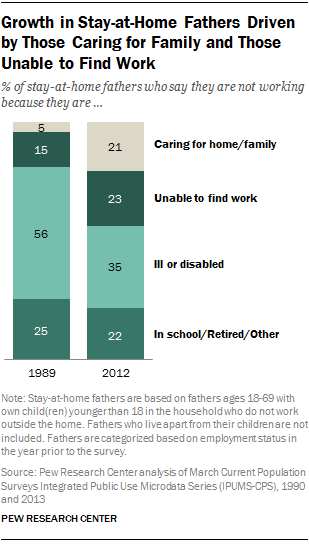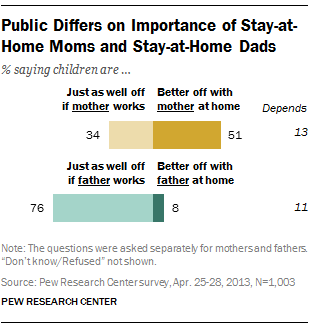 The number of fathers who do not work outside the home has risen markedly in recent years, up to 2 million in 2012.1 High unemployment rates around the time of the Great Recession contributed to the recent increases, but the biggest contributor to long-term growth in these “stay-at-home fathers” is the rising number of fathers who are at home primarily to care for their family.
The number of fathers who do not work outside the home has risen markedly in recent years, up to 2 million in 2012.1 High unemployment rates around the time of the Great Recession contributed to the recent increases, but the biggest contributor to long-term growth in these “stay-at-home fathers” is the rising number of fathers who are at home primarily to care for their family.
The number of fathers who are at home with their children for any reason has nearly doubled since 1989, when 1.1 million were in this category.2 It reached its highest point—2.2 million—in 2010, just after the official end of the recession, which spanned from 2007 to 2009. Since that time, the number has fallen slightly, driven mainly by declines in unemployment, according to a new Pew Research Center analysis of U.S. Census Bureau data.3
 While most stay-at-home parents are mothers, fathers represent a growing share of all at-home parents – 16% in 2012, up from 10% in 1989. Roughly a quarter of these stay-at-home fathers (23%) report that they are home mainly because they cannot find a job. Nearly as many (21%) say the main reason they are home is to care for their home or family. This represents a fourfold increase from 1989, when only 5% of stay-at-home fathers said they were home primarily to care for family.
While most stay-at-home parents are mothers, fathers represent a growing share of all at-home parents – 16% in 2012, up from 10% in 1989. Roughly a quarter of these stay-at-home fathers (23%) report that they are home mainly because they cannot find a job. Nearly as many (21%) say the main reason they are home is to care for their home or family. This represents a fourfold increase from 1989, when only 5% of stay-at-home fathers said they were home primarily to care for family.
Still, the largest share of stay-at-home fathers (35%) is at home due to illness or disability. This is in sharp contrast to stay-at-home mothers, most of whom (73%) report that they are home specifically to care for their home or family4; just 11% are home due to their own illness or disability.
A rise in the number of stay-at-home fathers is occurring side by side with another important parenting trend of the past half century: a rising share of fathers who don’t live with their children at all.5 About 16 percent of fathers with young children lived apart from all of their children. This report, however, focuses directly on the vast majority of fathers with children under the age of 18 who are living with at least one of those children. Whites are significantly more likely than blacks and Hispanics to be living with their children. Fathers with higher levels of education are also more likely than less educated dads to be living with their kids. Also worth noting: mothers are far more likely than fathers to be living with their children.
As is the case among mothers, stay-at-home fathers are less well-off financially and have lower educational attainment than their working counterparts. At-home fathers are twice as likely to lack a high school diploma as working fathers (22% vs. 10%). And almost half (47%) of stay-at-home fathers are living in poverty, compared with 8% of working fathers. This poverty figure is even higher than among stay-at-home mothers (34% of whom are in poverty), and may be due, in part, to the fact that stay-at-home fathers are far less likely to have a working spouse than stay-at-home mothers (50% vs. 68%) and are more likely to be ill or disabled than stay-at-home mothers (35% vs. 11%).
Stay-at-home fathers also tend to be older than stay-at-home mothers, which may partially explain why so many are home due to illness or disability. Just 24% of stay-at-home dads are less than 35 years of age, but 42% of stay-at-home mothers are. And stay-at-home fathers are twice as likely to be 45 years or older (43% are, compared with 21% of stay-at-home mothers).
 The public is largely supportive of the idea of mothers staying at home with their children, but they place less value on having a stay-at-home father. In a 2013 Pew Research Center survey, fully 51% of respondents said children are better off if their mother is home and doesn’t hold a job. By comparison, only 8% said children are better off if their father is home and doesn’t work. On the other hand, 34% of adults said children are just as well off if their mother works, while 76% said the same about children with working fathers.
The public is largely supportive of the idea of mothers staying at home with their children, but they place less value on having a stay-at-home father. In a 2013 Pew Research Center survey, fully 51% of respondents said children are better off if their mother is home and doesn’t hold a job. By comparison, only 8% said children are better off if their father is home and doesn’t work. On the other hand, 34% of adults said children are just as well off if their mother works, while 76% said the same about children with working fathers.
There are many potential reasons why more fathers with young children are at home these days. A 2012 Pew Research Center survey found that working fathers with children under age 18 are just as likely as working mothers to say that it is difficult for them to balance the responsibilities of their job with the responsibilities of their family. In addition, roughly equal shares of working fathers (48%) and mothers (52%) said they would prefer to be at home raising their children, but they need to work because they need the income.
The remainder of this report analyzes the likelihood of being a stay-at-home father, as well as the reasons some fathers are at home, and the profiles of employed fathers and stay-at-home fathers. Chapter 1 highlights trends in the likelihood of being a stay-at-home father among those dads who live with their children. It also illustrates how the likelihood of being a stay-at-home father varies for different demographic groups. Chapter 2 highlights the changing reasons that fathers give for staying at home, and Chapter 3 provides profiles of both stay-at-home fathers and their working counterparts.
About the Data
Analyses of the trends and demographic characteristics of U.S. fathers who live with their children are based on data from the 1990-2013 Annual Social and Economic Supplement (ASEC) of the Current Population Survey (CPS), which is conducted jointly by the U.S. Census Bureau and the Bureau of Labor Statistics. These data are collected each March and included about 90,000 household interviews in 2013. The data were obtained from the Integrated Public Use Microdata database (IPUMS-CPS), provided by the University of Minnesota. Further information about the IPUMS is available at http://www.ipums.org.
The Pew Research Center analyses include all men ages 18-69 who report living with at least one of their own children (biological, step or adopted) younger than 18 years of age. Fathers are categorized as “working” or “stay-at-home” based upon their employment status during the prior year. This is generally similar to the approach adopted by the U.S. Census Bureau.
However, while the Pew Research Center estimates that about 2 million fathers are stay-at-home dads, the Census Bureau, which uses a much more restrictive definition, puts that number at about 214,000.
While the Census Bureau limits the definition of stay-at-home fathers to those living with children (under the age of15) who state that they are home for the entire year in order to care for home and family, the definition used here encompasses any father (of a child younger than 18) who has not worked for pay in the prior year, regardless of the reason.
Furthermore, when discussing stay-at-home parents, the Census typically limits analysis to families with a married husband and wife, where one spouse is in the labor force all of the prior year. In contrast, the definitions used here are not contingent on marital status, having a spouse or partner of the “opposite” sex, or on the work status of the spouse or partner.
Determining an optimal definition of stay-at-home fathers (and mothers) is difficult. For instance, summarily excluding fathers who are primary caregivers, but who also worked at least a few hours in the prior year may lead to an underestimate of the actual numbers of stay-at-home fathers. On the other hand, some might argue that fathers who are home due to an inability to work should not be included as stay-at-home fathers, even though they may be serving as the primary caregiver. See this qualitative analysis for interesting insights on how caregiving fathers define themselves, and how various adjustments in the Census definition of stay-at-home fatherhood would affect their national estimates of stay-at-home fathers.
A Note on Terminology
Unless otherwise noted, “fathers,” in this report are men ages 18-69 who are living with their own children (biological, step or adopted) younger than 18.
“Stay-at-home fathers” refers to those fathers not employed for pay at all in the prior year and living at home with their children younger than 18.
“Working fathers” refers to those who worked for pay at some point in the prior year, and who were living with their children younger than 18. This includes fathers who may have worked part-time, and those who worked from home. The small share of fathers who performed unpaid work in a family business are also classified as “working fathers”.
All references to whites, blacks and Asians are to the non-Hispanic components of those populations. Asians also include Pacific Islanders. Hispanics are of any race.
“Foreign born” refers to persons born outside of the United States, including those born in Puerto Rico or other U.S. territories. “Native born” or “U.S. born” refers to persons born in the United States.
References to respondents who are “high school graduates” or who have a “high school diploma” also include those who have earned an equivalent degree, such as a GED (General Educational Development) certificate.
Poverty is based on the U.S. Census Bureau measure. This measure is defined by an income threshold that is dependent on family composition and income, adjusted for inflation. In 2012, the official poverty threshold for a family of four was $23,283.


